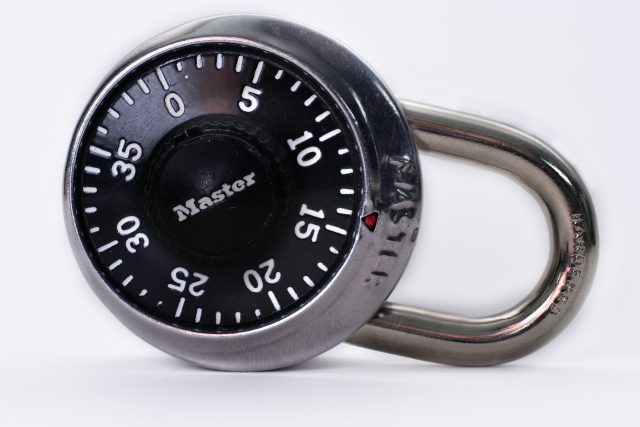
There's a vulnerability in Master Lock branded padlocks that allows anyone to learn the combination in eight or fewer tries, a process that requires less than two minutes and a minimal amount of skill to carry out.
The exploit involves lifting up a locked shackle with one hand while turning the combination dial counterclockwise starting at the number 0 with the other. Before the dial reaches 11, there will be three points where the dial will resist being turned anymore. One of them will be ignored as it is exactly between two whole numbers on the dial. The remaining two locations represent locked positions. Next, an attacker again lifts the locked shackle, this time with less force, while turning the dial clockwise. At some point before a full revolution is completed, the dial will resist being turned. (An attacker can still turn through it but will physically feel the resistance.) This location represents the resistance location. The two locked positions and the one resistance position are then recorded on a Web page that streamlines the exploit.
The page responds with the first digit of the combination and two possible digits for the last digit. By testing which of the possible last digits has more "give," an attacker can quickly figure out which one is correct. By eliminating the false digit from the Web form, the page will automatically populate the eight possible numbers for the second digit of the combination.
Now that the attacker knows the first and last digits and knows the second digit is one of eight possible numbers, the hack is a simple matter of trying each possible combination until the correct one opens the lock. The following video provides a simple tutorial.
The technique was devised by Samy Kamkar, a serial hacker who has created everything from stealthy keystroke-pilfering USB chargers to DIY stalker apps that mined Google Streetview. In 2005, he unleashed the Samy worm, a cross-site scripting exploit that knocked MySpace out of commission when it added more than one million MySpace friends to Kamkar's account.
Kamkar told Ars his Master Lock exploit started with a well-known vulnerability that allows Master Lock combinations to be cracked in 100 or fewer tries. He then physically broke open a combination lock and noticed the resistance he observed was caused by two lock parts that touched in a way that revealed important clues about the combination. (He likened the Master Lock design to a side channel in cryptographic devices that can be exploited to obtain the secret key.) Kamkar then made a third observation that was instrumental to his Master Lock exploit: the first and third digit of the combination, when divided by four, always return the same remainder. By combining the insights from all three weaknesses he devised the attack laid out in the video.
It's by no means the only way to break the security of a popular padlock. It comes a few years after Master Lock engineers developed new padlocks that resisted a popular form of attacks using shims made from soft drink cans. Kamkar said he has tried his exploit on more than a dozen Master Lock combination locks, and so far it has worked on all of them. In the coming weeks, he plans to unveil more details, including an Arduino-based robot that streamlines the exploit.
Post updated to change "any" in the headline to "many."
Watch Ars staffers put the hack to the test.
reader comments
131